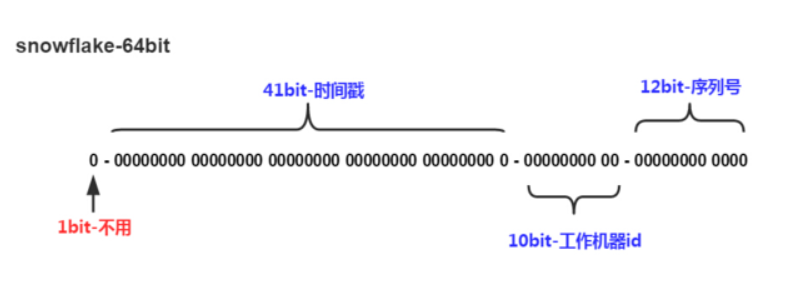原理
Twitter的雪花算法SnowFlake,使用Java语言实现。
SnowFlake算法产生的ID是一个64位的整型,结构如下(每一部分用“-”符号分隔):

1位标识部分,在java中由于long的最高位是符号位,正数是0,负数是1,一般生成的ID为正数,所以为0;
41位时间戳部分,这个是毫秒级的时间,一般实现上不会存储当前的时间戳,而是时间戳的差值(当前时间-固定的开始时间),这样可以使产生的ID从更小值开始;41位的时间戳可以使用69年,(1L << 41) / (1000L * 60 * 60 * 24 * 365) = 69年;
10位节点部分,Twitter实现中使用前5位作为数据中心标识,后5位作为机器标识,可以部署1024个节点;
12位序列号部分,支持同一毫秒内同一个节点可以生成4096个ID;
SnowFlake算法生成的ID大致上是按照时间递增的,用在分布式系统中时,需要注意数据中心标识和机器标识必须唯一,这样就能保证每个节点生成的ID都是唯一的。或许我们不一定都需要像上面那样使用5位作为数据中心标识,5位作为机器标识,可以根据我们业务的需要,灵活分配节点部分,如:若不需要数据中心,完全可以使用全部10位作为机器标识;若数据中心不多,也可以只使用3位作为数据中心,7位作为机器标识。
snowflake生成的ID整体上按照时间自增排序,并且整个分布式系统内不会产生ID碰撞(由datacenter和workerId作区分),并且效率较高。这个算法单机每秒内理论上最多可以生成1000*(2^12),也就是409.6万个ID。
源码
/**
* 描述: Twitter的分布式自增ID雪花算法snowflake (Java版)
*
* @author jinzg
* @create 2018-03-14 12:37
**/
public class IdWorker {
/**
* 起始的时间戳
*/
private final long twepoch = Date
.from(LocalDate.of(2018, 1, 1).atStartOfDay()
.atZone(ZoneId.systemDefault()).toInstant()).getTime();
/**
* 每一部分占用的位数
*/
private final long sequenceBits = 12L;
private final long workerIdBits = 5L;
private final long datacenterIdBits = 5L;
/**
* 每一部分的最大值
*/
private final long maxWorkerId = -1L ^ (-1L << workerIdBits);
private final long maxDatacenterId = -1L ^ (-1L << datacenterIdBits);
private final long sequenceMask = -1L ^ (-1L << sequenceBits);
/**
* 每一部分向左的位移
*/
private final long workerIdShift = sequenceBits;
private final long datacenterIdShift = sequenceBits + workerIdBits;
private final long timestampLeftShift = sequenceBits + workerIdBits + datacenterIdBits;
private long workerId;// 数据中心
private long datacenterId;// 机器标识
private long sequence = 0L;// 序列号
private long lastTimestamp = -1L;// 上一次时间戳
/**
* Init.
*/
@PostConstruct
public void init() {
try {
String ip = IpUtils.getRealIp();
if (StringUtils.isEmpty(ip)) {
throw new RuntimeException("IdWorker get ip is empty");
}
this.workerId = this.datacenterId = Math.abs(ip.hashCode() % 31);
log.info("ip:{},workerId:{},datacenterId;{}", ip, workerId, datacenterId);
} catch (SocketException e) {
log.error("init error,error:{}", e);
throw new RuntimeException("IdWorker init error");
}
}
/**
* Instantiates a new Id worker.
*/
public IdWorker() {
super();
}
/**
* Instantiates a new Id worker.
*
* @param workerId the worker id
* @param datacenterId the datacenter id
*/
public IdWorker(long workerId, long datacenterId) {
if (workerId > maxWorkerId || workerId < 0) {
throw new IllegalArgumentException(
String.format("worker Id can't be greater than %d or less than 0", maxWorkerId));
}
if (datacenterId > maxDatacenterId || datacenterId < 0) {
throw new IllegalArgumentException(String
.format("datacenter Id can't be greater than %d or less than 0", maxDatacenterId));
}
this.workerId = workerId;
this.datacenterId = datacenterId;
}
/**
* Next id long.
*
* @return the long
*/
public synchronized long nextId() {
long timestamp = timeGen();
if (timestamp < lastTimestamp) {
throw new RuntimeException(
String.format("Clock moved backwards. Refusing to generate id for %d milliseconds",
lastTimestamp - timestamp));
}
if (lastTimestamp == timestamp) {
sequence = (sequence + 1) & sequenceMask;
if (sequence == 0) {
timestamp = tilNextMillis(lastTimestamp);
}
} else {
sequence = 0L;
}
lastTimestamp = timestamp;
return ((timestamp - twepoch) << timestampLeftShift)
| (datacenterId << datacenterIdShift)
| (workerId << workerIdShift)
| sequence;
}
/**
* Til next millis long.
*
* @param lastTimestamp the last timestamp
* @return the long
*/
protected long tilNextMillis(long lastTimestamp) {
long timestamp = timeGen();
while (timestamp <= lastTimestamp) {
timestamp = timeGen();
}
return timestamp;
}
/**
* Time gen long.
*
* @return the long
*/
protected long timeGen() {
return System.currentTimeMillis();
}
/**
* test
*/
static class IdWorkThread implements Runnable {
private Set<Long> set;
private IdWorker idWorker;
/**
* Instantiates a new Id work thread.
*
* @param set the set
* @param idWorker the id worker
*/
public IdWorkThread(Set<Long> set, IdWorker idWorker) {
this.set = set;
this.idWorker = idWorker;
}
@Override
public void run() {
while (true) {
long id = idWorker.nextId();
System.out.println(Thread.currentThread().getName() + ":" + id);
if (!set.add(id)) {
System.out.println("duplicate:" + id);
}
}
}
}
/**
* The entry point of application.
*
* @param args the input arguments
*/
public static void main(String[] args) {
Set<Long> set = new HashSet<Long>();
final IdWorker idWorker1 = new IdWorker(0, 0);
final IdWorker idWorker2 = new IdWorker(1, 0);
Thread t1 = new Thread(new IdWorkThread(set, idWorker1));
Thread t2 = new Thread(new IdWorkThread(set, idWorker2));
t1.setDaemon(true);
t2.setDaemon(true);
t1.start();
t2.start();
try {
Thread.sleep(10000);
} catch (InterruptedException e) {
e.printStackTrace();
}
}
}特点
优点:
- 快。
- 没有啥依赖,实现也特别简单。
- 知道原理之后可以根据实际情况调整各各位段,方便灵活。
缺点:
- 只能趋势递增。(有些也不叫缺点,网上有些如果绝对递增,竞争对手中午下单,第二天在下单即可大概判断该公司的订单量,危险!!!)
- 依赖机器时间,如果发生回拨会导致可能生成id重复。
来源:oschina
链接:https://my.oschina.net/u/2910915/blog/1634534